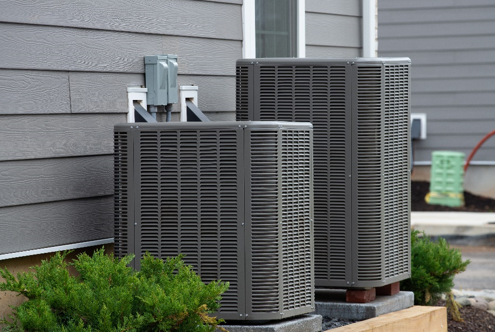As summer temperatures ramp up, ensuring your home’s air conditioning system can reliably beat the heat becomes paramount. But does your AC actually have enough capacity to keep interiors comfortably cool? Or are you unknowingly subjecting that undersized unit to excessive strain trying to compensate?
Sizing an air conditioner properly represents a critical yet frequently overlooked aspect of achieving ideal home climate control. Units operating above or below their intended cooling capacities simply can’t function at peak efficiency. That diminished performance not only compromises comfort but also shortens equipment lifespans while inflating energy bills.
This guide covers everything homeowners need to know about choosing the right sized AC for their square footage and specific environmental factors. We’ll explore key calculation methods and considerations like insulation levels to help you determine the perfect cooling match. You’ll also learn about alternative solutions when replacement proves necessary, plus sizing mistakes to avoid for maximizing return on investment.
Don’t resign your family to sweat-soaked summers because of improper AC sizing. Dial in the cooling capacity your home truly needs for year-round refreshment!

Understanding AC Sizing
Getting the air conditioner size just right for your home’s needs – not too small, but not oversized either – makes all the difference in cooling performance. You want that Goldilocks sweet spot where the unit can handle heat loads without overtaxing itself.
AC systems undersized for the square footage simply lack the oomph to provide enough cooling, especially during peak heat waves. You’ll notice lukewarm airflows, moisture buildup, and rooms that just never quite get comfortable no matter how low the thermostat setting goes. Plus, that constant strain from the unit running wide open increases repair risks quickly.
But oversizing creates its own issues too. Units with way more cooling capacity than needed tend to cycle on and off rapidly in short bursts as they overcool spaces. That inefficient start/stop pattern drives up energy use while decreasing dehumidification – potentially allowing moisture and mold troubles to take root. Excessive cycling also accelerates wear and tear on components from all that unnecessary stopping/restarting.
The goal is a nice middle ground where the system size matches your home’s precise thermal load calculations to a tee. Not too little cooling power, but not excessive overcapacity either. Just that perfectly scaled relief for your square footage, insulation levels, sun exposures, and other environmental factors.
Most HVAC professionals rely on industry calculations factoring in all those load variables to pinpoint an optimal AC size during air conditioning installations in Granville, OH. Only with that custom-fitted capacity can you achieve peak cooling efficiency, cost savings, and maximum equipment life without overtaxing operations.
Understanding those sizing considerations – square footage, insulation, climate, and more – represents the first step in ensuring your new system hits that “juuuust right” capacity sweet spot. Avoid the drawbacks of AC oversizing and undersizing right from the start.
Factors Influencing AC Size
While total square footage represents the obvious starting point for sizing calculations, it’s merely one piece of a much larger cooling load puzzle. A variety of other environmental variables influence just how much air conditioning capacity your Indiana or Ohio home truly requires for year-round comfort.
Room Size and Layout
Sure, you could simply calculate the cumulative interior square footage and leave it at that. But room dimensions and layout nuances play a huge role too. A rambling 2,000 sq ft ranch with a compartmentalized floor plan presents far different cooling challenges than a nice open-concept design of the same size. Factoring room volumes and ceiling heights prevents over or under sizing.
Climate and Geographic Location
Living in the midwestern Ohio and Indiana regions, we all know how intense summer heat and humidity levels can get. But even within this general area, microclimates and geographic factors like proximity to large cities or bodies of water impact thermal loads substantially. Homes in typically warmer Columbus zones naturally require higher AC capacities than more temperate rural areas upstate.
Home Insulation and Sealing
You can have the world’s most powerful air conditioner, but it won’t operate very efficiently if your home is a drafty, under-insulated energy sieve. Factoring insulation levels within walls, attic spaces, and foundations represents a critical part of the sizing equation. The same applies to any air leaks around windows, doors, and exterior wall penetrations that disrupt insulation’s effectiveness.
Window Size and Placement
Speaking of windows, their overall dimensions and cardinal directional orientation can significantly influence cooling needs too. Large west or south-facing window expanses create solar heat gain requiring higher AC capacities during peak afternoon sun. North and east-facing windows present far less radiant impact in comparison.
Occupancy and Usage Patterns
Do you spend most days outside the home while everyone’s at work or school? Or does your high-occupancy household generate lots of ambient heat from occupants, cooking, and electrical loads regularly? Even interior cooling priorities like dedicated home theater rooms warrant customized sizing considerations versus typical living spaces.
Sun Exposure and Shade
Depending on your property’s layout and surrounding vegetation, some homes just naturally catch more direct sunlight throughout the day – compounding those solar heat gain factors. Estimating sun exposures across all exterior elevations while accounting for any mature tree shading effects allows for more accurate sizing based on actual radiant conditions.
From microclimates and insulation levels to occupancy patterns and sun exposures, a wide range of variables beyond simple floor plans ultimately dictate just how much cooling power your home requires. Considering each specific factor allows for the most precise AC sizing possible to maximize efficiency and comfort.
Calculating the Right Size for Your Home
While factoring in variables like insulation and window exposures proves important, total square footage still represents the primary starting point for determining your home’s AC sizing needs. Established guidelines allow you to estimate those initial cooling capacity requirements before making any custom adjustments.
The BTU Sizing Chart
Air conditioner sizes are measured in British Thermal Units (BTUs) per hour – indicating their heat absorption capabilities over that time period. Use this general chart as a baseline for initial capacity estimates based on your home’s overall square footage:
| Room Size (Sq Ft) | Recommended BTUs |
| 100-150 | 5,000 |
| 150-250 | 6,000 |
| 250-300 | 7,000 |
| 300-350 | 8,000 |
| 350-400 | 9,000 |
| 400-450 | 10,000 |
| 450-550 | 12,000 |
| 550-700 | 14,000 |
| 700-1,000 | 18,000 |
| 1,000-1,200 | 21,000 |
| 1,200-1,400 | 23,000 |
| 1,400-1,500 | 24,000 |
| 1,500-2,000 | 30,000 |
| 2,000-2,500 | 34,000 |
Example Calculations
Let’s say your Ohio home clocks in around 1,800 square feet. Following the chart, that would put you somewhere between 24,000 – 30,000 BTUs initially just based on square footage alone.
But what if you have an older 1,500 square foot house with those tiny 8ft ceilings throughout? Ceiling heights below average would actually decrease cooling demands, potentially allowing you to size down around 24,000 BTUs or so.
On the flip side, consider a newer 1,600 square foot open-concept layout. All those interconnected spaces might push the BTUs towards 30,000 to sufficiently condition that open airflow.
Adjustments for Unique Features
While convenient rules of thumb, these BTU guidelines only account for square footage – not all those other critical load factors we discussed earlier like insulation, window exposures, climate concerns, and more. That’s why most HVAC professionals utilize advanced calculations factoring in those realities.
For instance, they might decrease BTU estimates for well-insulated homes in milder climates yet increase them for places receiving intense summer sun exposure. Larger west-facing window designs could bump requirements up further still to offset that radiant heat intake. Occupancy levels and home theater spaces might also boost calculations.
Only by considering your home’s complete thermal characteristics can you arrive at a truly accurate AC size. Don’t simply rely on flat square footage assumptions – allow the pros to evaluate your unique scenario through their specialized calculations. Properly accounting for all influencing factors upfront ensures maximum comfort, efficiency, and equipment longevity.
Professional Assessment
While online calculators and rules of thumb provide a decent starting point for ballparking your home’s air conditioning sizing needs, they simply can’t account for all the unique variables impacting actual thermal load factors. From insulation levels and sun exposures to heat-generating occupancy patterns, so many property-specific nuances influence ideal cooling capacities.
That’s why consulting professional HVAC technicians to conduct an in-depth assessment of your property proves the wisest route for any sizing decisions – whether installing a new AC system from scratch or determining if existing cooling equipment still has sufficient capacity as your home’s conditions change over the decades.
During these comprehensive evaluations, experienced cooling experts employ sophisticated calculation software factoring in all relevant details about your home’s construction characteristics. They’ll carefully take measurements and gather data on everything from square footage and room volumes to window placements, ventilation considerations, ductwork analysis, and more.
But it’s not just a numbers game – these seasoned pros visually inspect areas homeowners may overlook too. Thermal scanning can reveal insulation voids or drafty leak points exacerbating cooling loads, for instance. Shade analysis quantifies precisely how surrounding trees and other obstructions impact solar heat gain vulnerabilities as seasons change.
With all this empirical evidence compiled into advanced software models, HVAC companies can then extrapolate your home’s true, peak cooling demand down to the precise BTU. Only with such specificity can they size new AC installations optimally – ensuring you receive the maximum bang for your investment buck in terms of operating costs and system lifespans.
Even if replacements aren’t yet required, periodic professional load calculations allow a proactive peek into the future too. Certified technicians can identify looming capacity shortfalls before cooling systems become overwhelmed by factors like home additions, new window installations, area construction changing shade dynamics, and more. A little foresight enables properly accommodating evolving demands over time.
While online tools provide convenient rough guidelines, they simply cannot replicate the comprehensive, property-specific insights only trained HVAC assessors can gather through their specialized knowledge and resources. Investing in professional AC sizing consultations with Bassett Services ensures your cooling system matches your home’s unique needs optimally – both now and for years down the road as those needs evolve.
Common Mistakes and How to Avoid Them
Even armed with all the preliminary research and best calculations in the world, homeowners can still fall victim to some easily avoided pitfalls when selecting air conditioning system sizes. Overlooking key factors or relying too heavily on outdated rules of thumb frequently leads to improper sizing – whether that’s undersizing units for insufficient cooling or oversizing them for inefficient overkill.
Don’t Underestimate Insulation’s Impact
One of the most common sizing blunders stems from underappreciating just how much high-quality insulation throughout your home’s walls, attics, and foundations can offset cooling demands. All those dense thermal barriers keep radiant heat outdoors where it belongs rather than infiltrating living spaces.
Homes with robust insulation simply don’t require as much raw AC capacity as their under-insulated counterparts absorbing outdoor temperatures more readily. Skipping the insulation inspection during load calculations means oversizing – and overpaying – for more cooling power than actually needed.
Account for Solar Heat Gain Comprehensively
Another typical mistake centers around incomplete evaluations of your home’s sun exposure profiles across varying days, seasons, and exterior facing orientations. Just glancing out front windows and noting shading conditions gives an incomplete picture if intense afternoon rays start baking rear elevations later. Thorough site assessments tracking solar radiant heat pathways represent a must.
Factor In All Environmental Conditions
Speaking of exposure considerations, failing to account for regional climate characteristics also contributes to AC sizing errors. Homes in Ohio’s humid continental zones simply can’t assume the same cooling capacities as drier Indiana properties, for instance. Muggy summer air masses place greater dehumidification demands on air conditioning equipment.
Include All Interior Heat Sources
From high-occupancy family environments generating more body heat to household appliances and harsh window placements subjecting specific rooms to hotter temperatures – your interior cooling load estimation needs to consider varying space-by-space conditions. That open-concept kitchen with abundant west-facing glass will likely require higher localized AC tonnage.
Don’t Forget Future-Proofing Potential
Finally, keep in mind that each home’s cooling needs fluctuate over decades as circumstances evolve – new additions, renovations altering environments like shading patterns, aging insulation degrading effectiveness, and more. While you can’t predict those specific future details, you can plan ahead by oversizing slightly to accommodate potential increases with relatively low-cost equipment upgrades later on.
At the end of the day, properly sizing an air conditioning system requires accounting for the complete picture – both environmental factors impacting cooling requirements today as well as potential evolutions influencing operational demands down the road. Prioritizing professional assessments incorporating advanced calculation methods will ensure you achieve that optimal comfort sweet spot from day one.
Alternative Cooling Solutions
For some homes, a traditional central air conditioning system just doesn’t make the most practical or economical sense. Whether you’re dealing with problematic ductwork constraints, astronomical install costs, or just don’t need whole-house cooling capabilities, exploring alternative cooling methods could provide a more suitable solution.
Ductless Mini-Split Systems
One of the most popular alternatives to traditional ducted ACs, ductless mini-split units allow you to selectively cool specific zones or rooms only. Their compact design consisting of an outdoor condenser and indoor air handlers linked via a small conduit makes installation a breeze – no bulky ductwork is required.
Beyond easy placement flexibility in new construction or additions, mini-splits also provide an ideal retrofit solution for older homes lacking ductwork already. You simply mount the indoor blowers in whichever living spaces need a targeted cooling boost.
Window Units & Portable ACs
For ultra-affordable spot cooling in one or two key rooms, those old-school window-mounted air conditioners remain a viable stopgap option too. More maneuverable portable AC units on wheels provide another space-saving approach for semi-permanent installations as needed as well.
While hardly as sleek as ductless set-ups and certainly less efficient than whole-house solutions, window and portable units make for cheap supplemental cooling when you just need to cut through the muggiest summer days’ heat waves.
Whole-House Fans & Attic Fans
Trying to enhance natural air circulation through your home provides another budget-friendly alternative to traditional AC installations too. Whole-house fans mounted in ceilings draw in fresh outdoor air through open windows and exhaust warm interior air outward.
Similarly, attic exhaust fans help purge excess heat accumulating in those oven-like attic spaces that would otherwise radiate down into living quarters below. While not actual air “conditioning” like compression cycle systems, these fans promote crucial airflow to make any existing cooling techniques you do use more effective overall.
Evaporative Coolers
Also marketed as “swamp coolers,” evaporative cooling systems operate by essentially blowing air over water-saturated pads. As water evaporates absorbing thermal energy, it cools and humidifies that blown airstream for distribution through homes.
Best suited for drier climates where introduced humidity won’t exacerbate mugginess, evaporative coolers provide a far more energy-efficient approach compared to compressor-based ACs. They’re also cheaper to purchase and install as a whole-house option – great for those prioritizing sustainability and cost savings.
When whole-home ducted AC systems prove unviable or too expensive, any of these alternative approaches offer creative pathways to still maximize comfort through strategic cooling applications. With some professional guidance exploring viable options, you’re bound to find the perfect custom solution!
Experience the Cooling Comfort with Bassett’s Professional AC Sizing
From maximizing energy savings and extending equipment lifespans to simply maintaining that elusive perfectly refreshing indoor oasis, properly sizing your home’s air conditioning system proves absolutely paramount. Cutting corners by guesstimating cooling needs based on square footage alone frequently misses the mark.
For Ohio and Indiana homeowners, that’s why consulting the professional HVAC experts at Bassett Services represents the wisest investment. Our certified technicians utilize advanced calculation software and comprehensive home assessments to pinpoint your property’s true thermal load factors down to the precise BTU.
Whether installing new high-efficiency cooling solutions or evaluating existing systems’ capacity, Bassett sizes every job optimally to meet your household’s unique demands. You can feel confident our recommendations maximize lasting comfort, efficiency, and return on investment.
Don’t resign another summer to thermostat frustrations and spiking utility bills from an improperly sized AC unit. Call Bassett Services at (317) 360-0054 and schedule your professional cooling consultation today!





